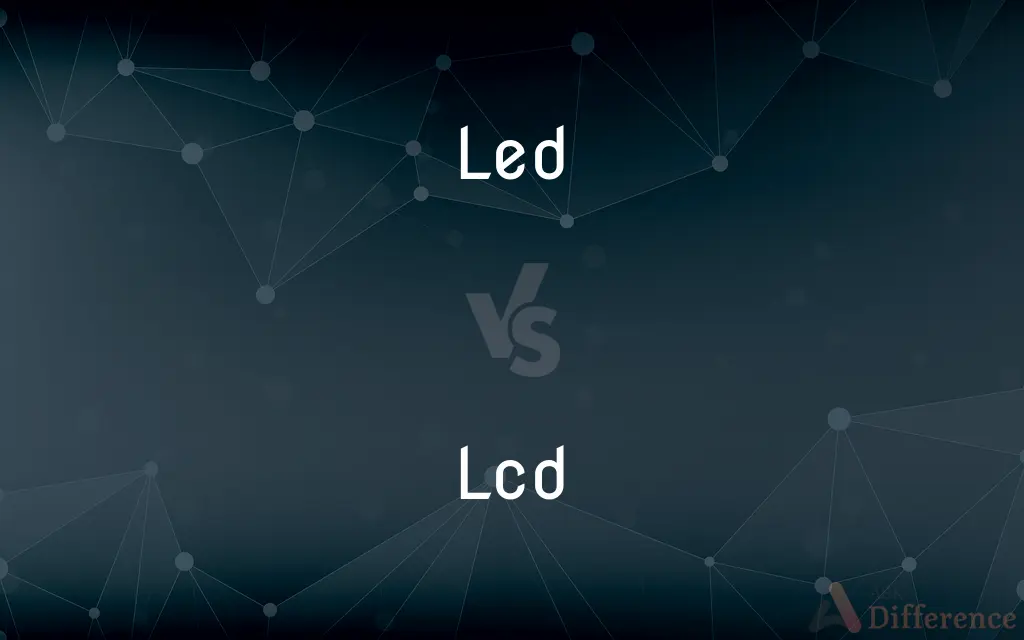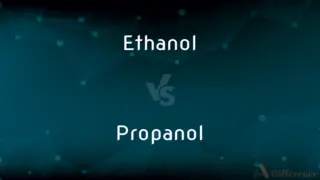LED vs. LCD — What's the Difference?
By Tayyaba Rehman — Updated on September 22, 2023
LED is a light-emitting diode; LCD stands for liquid crystal display. LED emits light, while LCD uses liquid crystals to control light passage. LED can be used as a backlight for LCD screens.

Difference Between LED and LCD
Table of Contents
ADVERTISEMENT
Key Differences
LED, or Light Emitting Diode, is a semiconductor light source that emits light when an electric current passes through it. LCD, on the other hand, stands for Liquid Crystal Display and represents a flat panel display that uses the light modulating properties of liquid crystals.
LEDs produce their own light, making them energy efficient and capable of producing vibrant colors. LCDs do not produce their own light. Instead, they rely on external light sources, often from LED backlights, to make the display visible.
LED displays are commonly found in indicators, signage, and increasingly, in TV screens. LCDs are pervasive in computer monitors, televisions, and handheld devices such as smartphones. Both LED and LCD technologies have distinct advantages and applications based on their characteristics.
LED screens generally have better contrast ratios and can offer deeper blacks than LCDs because they can completely turn off individual light sources. LCD screens, due to their reliance on a backlight, might not achieve the same depth of black since the light is always on, even if dimmed.
LEDs have a longer lifespan, are more energy-efficient, and can be made extremely thin. LCDs, when paired with LED backlights, combine the modulating properties of liquid crystals with the brightness and efficiency of LEDs, leading to widely-used LED-LCD hybrid displays.
ADVERTISEMENT
Comparison Chart
Meaning
Light Emitting Diode
Liquid Crystal Display
Light Source
Produces its own light
Requires an external light source
Efficiency
More energy efficient
Less energy efficient without LED backlight
Lifespan
Generally longer
Might be shorter
Contrast & Blacks
Higher contrast, deeper blacks
Might not achieve same depth of black
Compare with Definitions
Led
A semiconductor device that emits light when current flows through it.
The indicator on the remote is an LED that glows red when you press a button.
Lcd
A display relying on an external backlight, often LED, for visibility.
My laptop's LCD screen gives excellent visuals when paired with its LED backlight.
Led
A digital display technology that produces light from electron movement.
Many modern TVs use LED technology for clearer pictures.
Lcd
A flat-panel display technology using liquid crystals to control light passage.
My new watch has an LCD screen which displays time clearly.
Led
A tiny light source used in various applications from indicators to screens.
The LED on my computer shows it's still turned on.
Lcd
A technology used in monitors, TVs, and devices to present visual information.
The LCD on my camera helps me preview the photos I've taken.
Led
A diode that emits visible light when energized.
The LED lights on the stage made the concert visually stunning.
Lcd
A display type using polarized light and liquid crystals for image generation.
The clarity of the LCD TV in my living room makes movie nights enjoyable.
Led
An energy-efficient light source often used in electronic devices.
I replaced all my old bulbs with LED ones to save on electricity bills.
Lcd
A screen type that modulates light with the help of liquid crystal molecules.
The LCD monitor at my desk offers a crisp and vibrant display.
Led
A light-emitting diode (a semiconductor diode which glows when a voltage is applied)
Light sources can be fluorescent tubes, optical fibres, or LEDs
An LED display
Lcd
A digital display that uses liquid crystal cells that change reflectivity in an applied electric field; used for portable computer displays and watches etc.
Led
A semiconductor diode that converts applied voltage to light and is used in lamps and digital displays.
Led
Past tense and past participle of lead1.
Led
Simple past tense and past participle of lead
Led
Under somebody's control or leadership.
Led
Of a farm, etc.: managed by a deputy instead of the owner or tenant in person.
Led
Of Lead.
Led
Diode such that light emitted at a p-n junction is proportional to the bias current; color depends on the material used
Common Curiosities
How does an LCD work?
LCD works by modulating light using liquid crystals and requires an external backlight for visibility.
What does LED stand for?
LED stands for Light Emitting Diode.
Is LED a type of LCD?
No, LED is a light source, but it's commonly used as a backlight for LCD displays.
Why do some TVs say LED-LCD?
It means the TV uses an LCD for display and LEDs for backlighting.
Which lasts longer, LED or LCD?
Generally, LEDs have a longer lifespan than LCDs.
Are LED screens energy efficient?
Yes, LED screens are generally more energy efficient than non-LED LCD screens.
What's the primary light source for an LCD?
LCDs require an external light source, often LEDs or CCFLs.
Are LED screens more expensive than LCDs?
Not necessarily. The cost depends on various factors, including screen size, resolution, and additional features.
Which is more suitable for outdoor use, LED or LCD?
LED displays, especially OLEDs, tend to be more visible outdoors compared to LCDs.
Do all LCDs use LED backlights?
No, but LED backlights are the most common in modern LCD displays.
Can LEDs produce their own light?
Yes, LEDs produce their own light when electric current passes through them.
Which has better contrast, LED or LCD?
LED screens usually offer better contrast ratios than LCDs.
Are there environmental concerns with LEDs or LCDs?
Both have concerns, but LEDs generally consume less power, reducing their environmental impact compared to older LCD technologies.
Is the clarity of an LCD affected by its backlight type?
Yes, the quality of backlighting, such as LED, can influence the clarity and color accuracy of an LCD.
Why do LEDs produce vibrant colors?
LEDs produce pure and intense colors because they emit light directly with narrow color bands.
Share Your Discovery

Previous Comparison
Ethanol vs. Propanol
Next Comparison
Cafe vs. CafeteriaAuthor Spotlight
Written by
Tayyaba RehmanTayyaba Rehman is a distinguished writer, currently serving as a primary contributor to askdifference.com. As a researcher in semantics and etymology, Tayyaba's passion for the complexity of languages and their distinctions has found a perfect home on the platform. Tayyaba delves into the intricacies of language, distinguishing between commonly confused words and phrases, thereby providing clarity for readers worldwide.















































